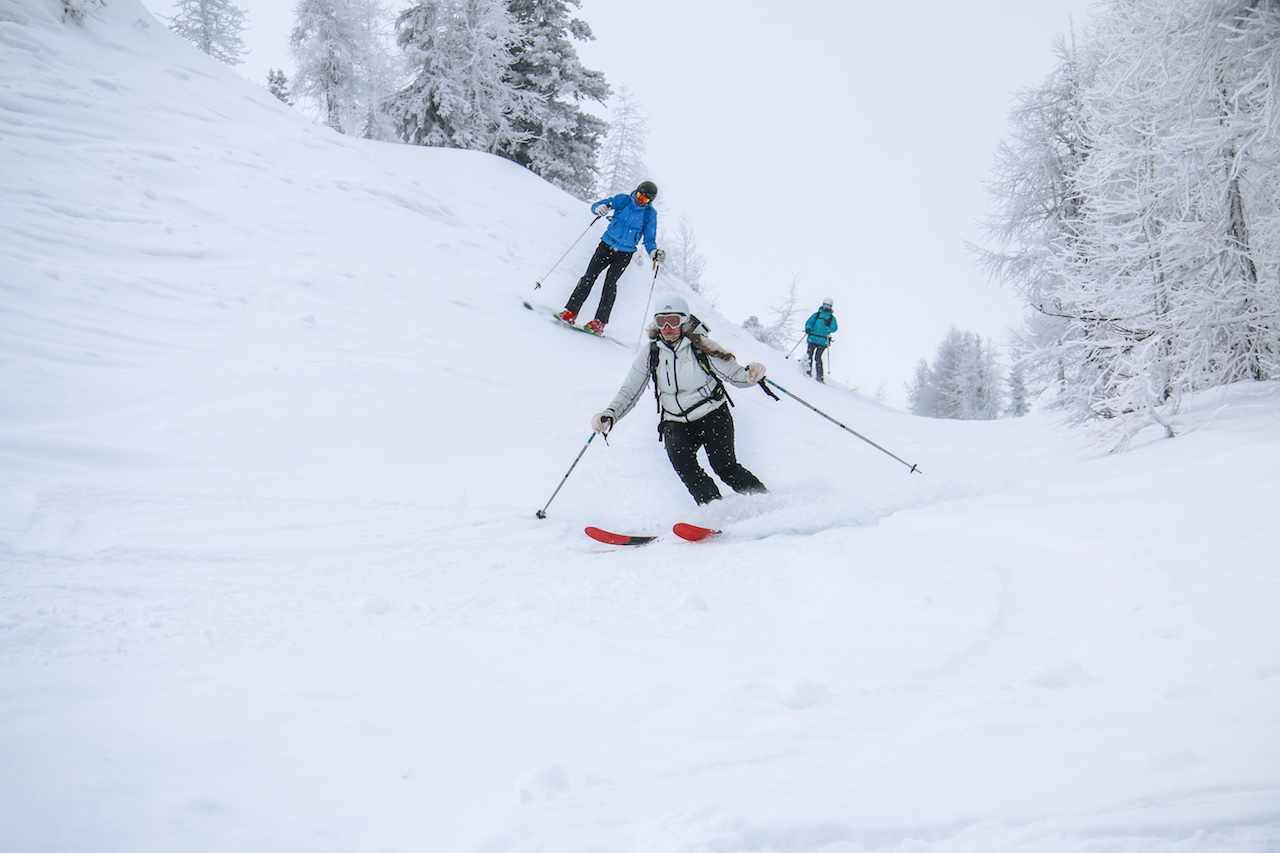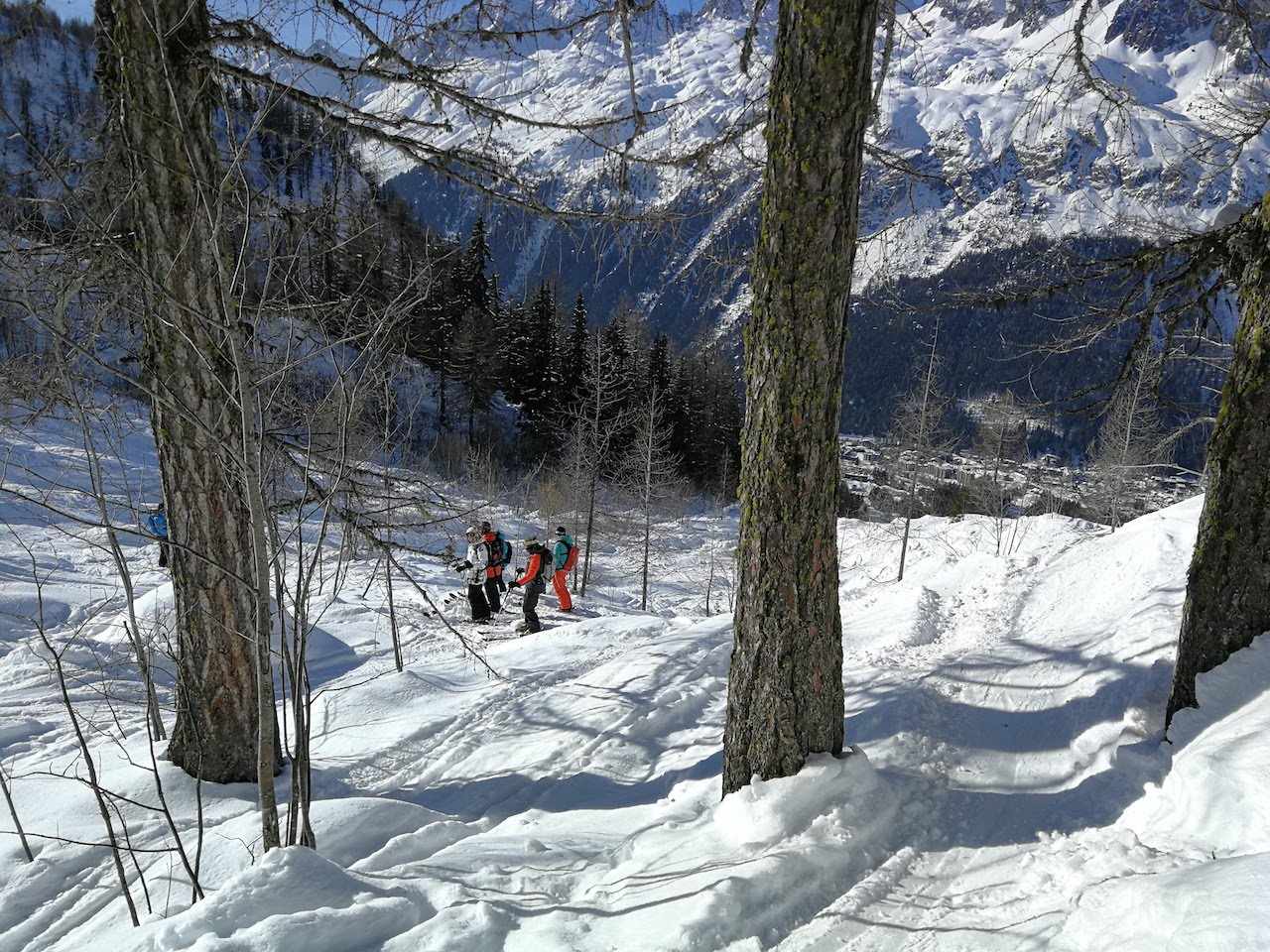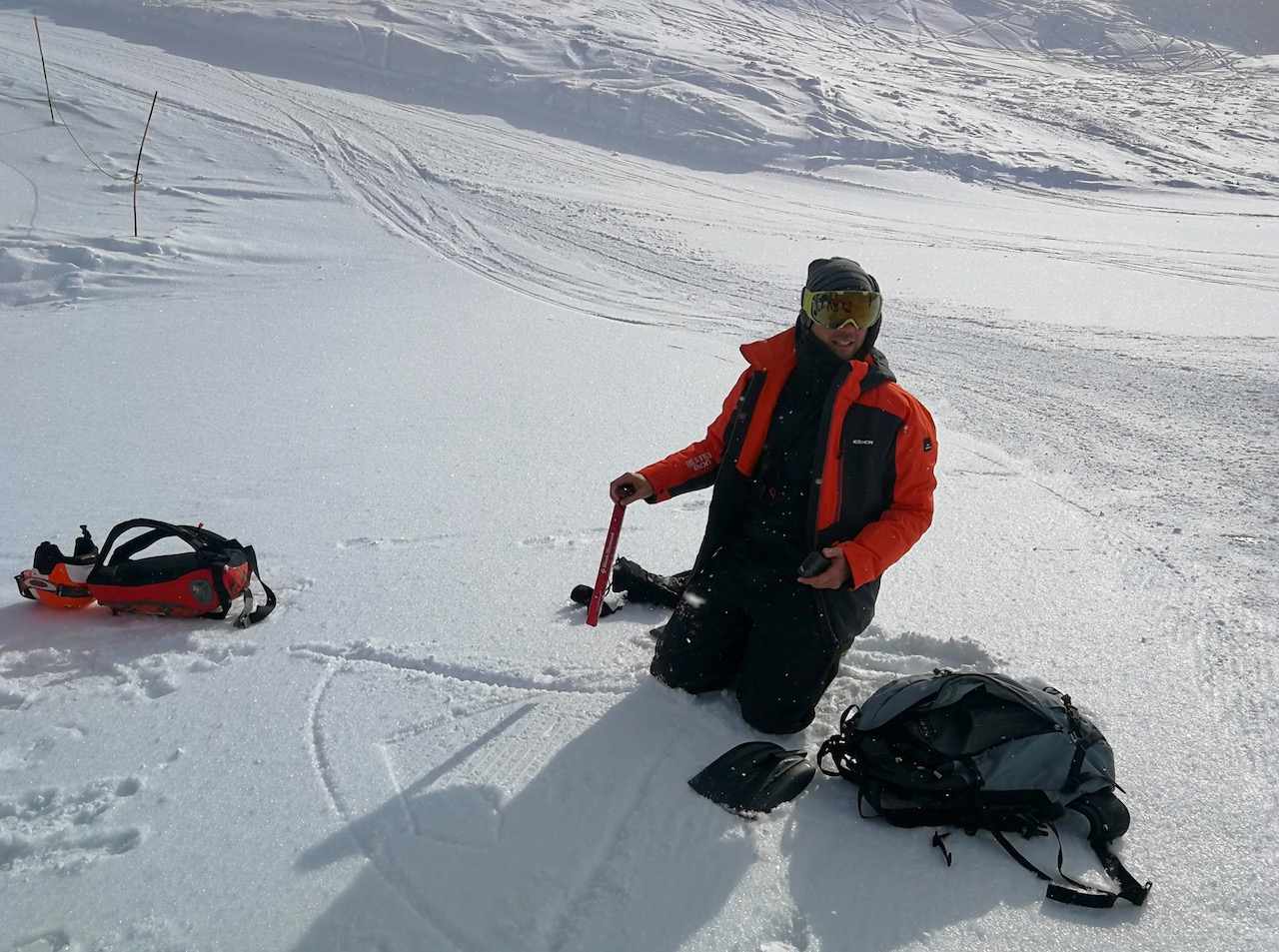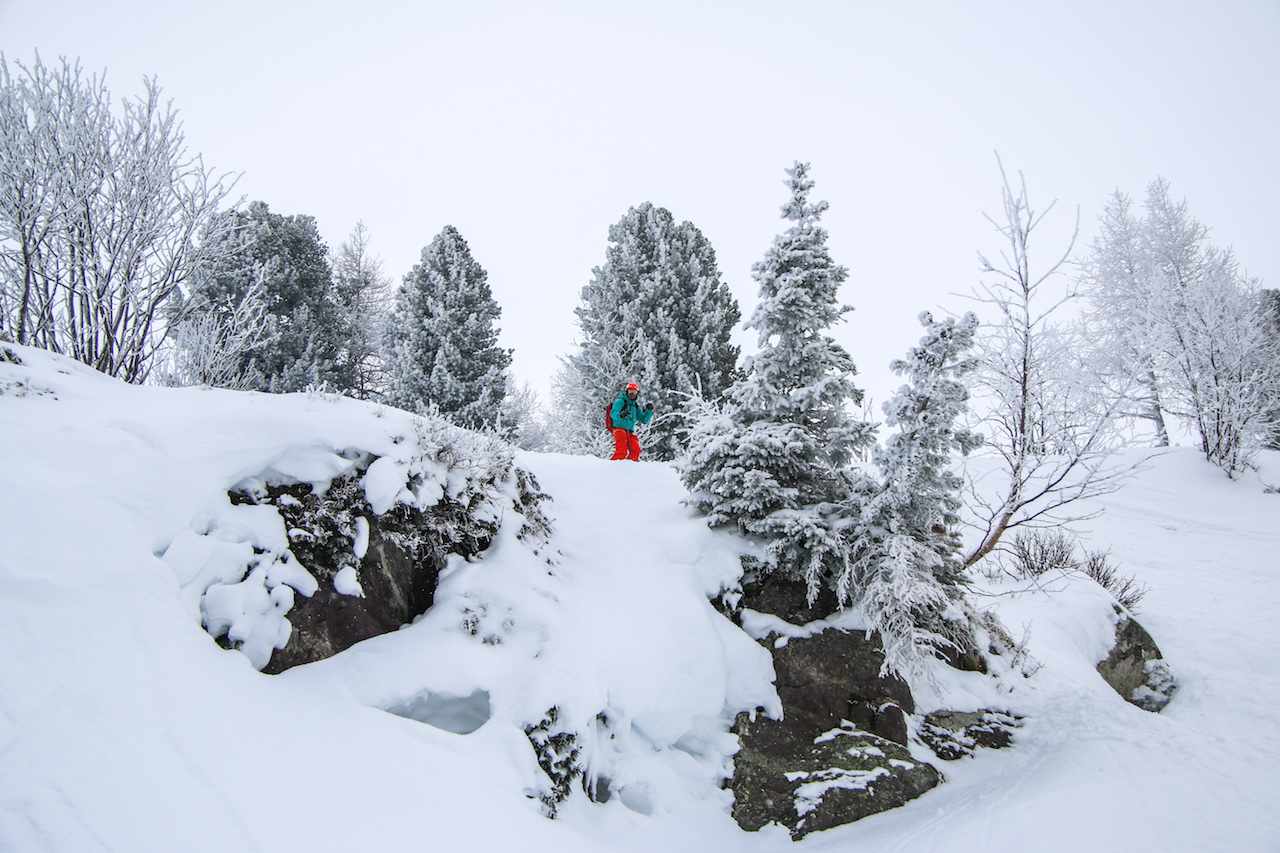Off-piste skiing is becoming increasingly popular thanks to the improvement in equipment and the opportunity to ski on untouched snow far away from the crowds, but is it for you?
Piste vs off-piste
The word “piste” comes from the French word for groomed trail or slope and the term has been adopted worldwide for a marked ski run. These slopes are maintained daily using tracked vehicles, ensuring a safe and pleasant experience for skiers and snowboarders. While the conditions are usually good, pisted slopes can still get icy and covered in moguls (snowy bumps), but this normally happens later in the day.
In contrast, off-piste skiing (also known as freeriding or backcountry skiing) refers to the unmarked or unpatrolled areas either inside or outside the ski resort’s boundaries. There are no signs and these areas are not maintained. There is also a risk of avalanches, rock fall and cliffs.

Gliding through powder at Le Tour in Chamonix (c) David Robertson
Marked pistes tend to be smooth and wide, with no unexpected lumps and bumps, at least when conditions are good. In contrast off-piste skiing is full of surprises as the snow can vary in texture and depth. One moment, you are gliding on soft powder, the next you are stuck in sticky “sludge” and you need to alter your movements. To help navigate the varied terrain you might choose to rent wider “freeride” skis, as the extra surface area helps provide flotation when skiing on powder.
Ski style
Off-piste skiing is technically quite different to traditional downhill skiing. For instance when making a turn off-piste, you need to put your weight on both skis rather than the outside ski, so that you don’t end up sinking into the deep snow. When skiing over moguls, you need to approach them head on and bend your knees as you turn in order to absorb the bump. Balance is key and holding your poles in front of you can help with posture.
How well do I need to ski if I want to go off-piste?
The outdoor sports organisation UCPA, specialists in offering off-piste skiing experiences, have a minimum requirement for anyone interested in signing up for one of their off-piste courses:
“You should be a very competent advanced level piste skier. You can ski all pistes including blacks confidently however during very tricky conditions such as low visibility or ice you may find black runs more challenging.”
This seems like a good measure for whether you are ready to go off-piste. I would also add that if you are a nervous skier or are afraid of falling over, off-piste skiing is probably not for you.
Why ski off-piste?
The quiet: During high season marked pistes can get very busy and accidents are commonplace due to collisions. Venturing off-piste allows you the chance to ski in total privacy on untouched snow.
The variety: You have the chance to ski on varied terrain, nipping through picturesque pine trees or through a mountain gully – the opportunities are endless.

Skiing off-piste offers real variety (c) Lucy Woods
The challenge: When you have been skiing for a long time, you can end up stuck in your comfort zone. By taking on the challenge of off-piste skiing you are forced to learn a different technical skill set and put yourself in new and sometimes scary situations. This can be a very rewarding experience.
Potential risks
Avalanches: This is an off-piste skier’s worst nightmare and they can happen quickly and without warning. The good news is that you can take safety measures by checking avalanche forecasts and avoiding areas where they are likely to happen. For example, avoid very steep slopes and ensure the areas behind you are at angle of less than 30°. It is important that you learn some basic avalanche training and carry avalanche equipment including a shovel, probe and transceiver – a device used to help locate someone trapped under the snow.

Basic avalanche training is important for anyone planning to ski off-piste (c) Lucy Woods
Rocks, tree roots and other obstacles: When skiing off-piste you need to be constantly vigilant for obstacles, particularly rocks and trees. Skiing over even a tiny rock can cause you to lose your balance and fall over. Obstacles are sometimes concealed under a thin layer of snow so mindless daydreaming is a no no.
Remote off-piste areas: Many off-piste areas can be easily reached from ski lifts, but some skiers choose to venture further afield. Should an accident happen mountain rescue might take longer to find you and those extra few minutes can have serious implications. Until you have become an experienced off-piste skier it’s better to stick close to the maintained pistes.
Important note: If you are planning to go off-piste with friends, make sure you are also accompanied by a fully qualified mountain guide or ski instructor as they will have an excellent knowledge of the terrain. Never ski off-piste alone.
A few practical things
Wrapping up warm: When off-piste skiing you will often be in the shade of trees, so it is important to wrap up warm. Thermals are an absolute must as temperatures can drop to below -17°C. On my last trip I wore the new thermal base layers by FLŌA, which are designed to keep you warm and dry in all types of snow conditions. The stretchy, seamless material fits to your body shape, and I found the M/L versions extremely comfortable (I am a women’s size 14 and 5’11).
Insurance: Many travel insurers will only cover you off-piste if you ski with a guide. Some won’t insure off-piste skiing at all, so make sure you check your insurance policy with a fine tooth comb, or better still call them and check.
Want to learn to ski off-piste?
Piste To Powder offer beginner off-piste ski courses in St. Anton, Lech and Zürs am Arlberg. Their certified local mountain guides will take you to the best snow and terrain and help you to push your limits while developing backcountry skills. They offer both open and private groups, with prices starting from €130.
Warren Smith Ski Academy have been operating in Verbier for more than 20 years. They run a 5-day off-piste academy that includes technical tuition and video analysis on two of the days. This is a great option for competent skiers who have never ventured off-piste before. Prices start from £469 for groups of eight.
If you already have some experience skiing off-piste, improve your skills with UCPA Argentière’s 4-day off-piste advanced skiing course. Prices start from only £444 per person, which includes full-board accommodation, ski pass, equipment hire, local bus pass, instruction and avalanche equipment. The official UK booking partner for UCPA is Action Outdoors.
New Generation organise off-piste ski clinics for both advanced backcountry skiers and those who have never skied off-piste before. Clinics take place over two days (four hours per day) in groups of 2-6 and cost €190 per course.

